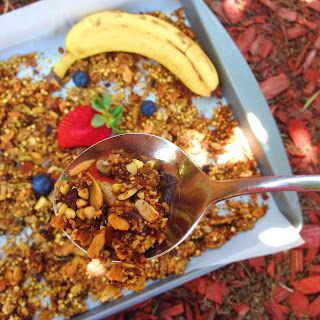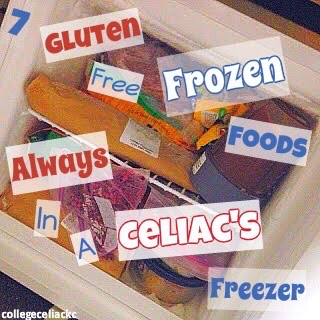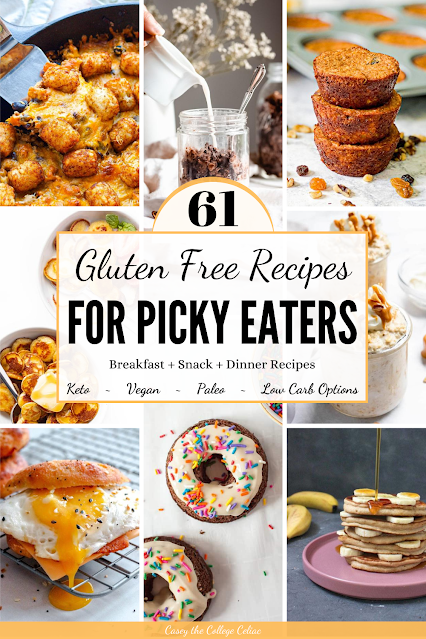7 Gluten Free Frozen Foods Always Found in a Celiac's Freezer
You've probably heard the saying: "If you fail to plan, you're planning to fail." Well, when it comes to eating gluten free with celiac disease, that quote is - for better or worse - 100% true. Although a gluten free diet doesn't have to be complicated, planning to have a few items on hand can make it even easier. My favorite secret weapon? Freezer foods.
In fact, on National Frozen Foods Day (today, in case you thought "Monday" and "holiday" was a paradox), I'm celebrating the foods I always have stashed in my freezer.
Whether you have celiac disease, eat gluten free or just want a healthier diet, here are seven foods (plus a handful of entire, allergy-friendly meals!) to keep in your freezer for easy breakfasts, snacks and savory meals!
Whether you have celiac disease, eat gluten free or just want a healthier diet, here are seven foods (plus a handful of entire, allergy-friendly meals!) to keep in your freezer for easy breakfasts, snacks and savory meals!
Breakfast
1. Frozen spinach, zucchini/squash, berries, bananas, etc.
Anytime you open my freezer, you'll always find some frozen produce. The exact fruits and veggies often vary by the season. For example, during the fall, I often freeze pomegranate seeds to keep them from going bad (and to enjoy them for the longest as possible). In the summer, you can find fruits like cantaloupe and berries that were on sale.
Some of the staples that always appear, though, are frozen spinach and chopped bananas. I can use them in my smoothies, but they also have a wide variety of other uses. The spinach can be defrosted and used for pizza, stir-frys, or really any baked/sautéed meal. Meanwhile, the bananas can be blended into banana ice cream, eaten straight out of the freezer (for a sweet, refreshing snack) or even defrosted and used in baked goods when you're low on ripe bananas.
 |
| Using defrosted frozen bananas makes this granola extra thick and clustery! |
In my opinion, you can never go wrong with frozen fruits and veggies!
2. Pre-made smoothies.
Now that I'm working (almost) full-time, I don't have the luxury of making a fresh smoothie every morning. Luckily, I've discovered that making a huge batch of smoothies ahead of time and defrosting them as needed works just as well!
The process is simple. First, create your smoothie as usual (may I suggest recipes like my Zucchini Bread Nice Cream, classic Banana Ice Cream, or Breakfast Buddha Bowl?). Then, pour your smoothies into freezer-safe containers. I like using glass mason jars or glass Tupperware. One pro tip: instead of putting on a lid to your mason jar, simply cover the top with a small plastic bag.
I made the mistake of screwing on jar lids and, when the smoothies expanded as they froze, they actually cracked my mason jars. (There were a few tears, I'll admit). Alternatively, you can be sure to leave two to three inches or so of space for the smoothie to expand.
 |
| This buddha bowl's base was actually pre-made and defrosted! |
Once you're ready to eat, simply pop your jar in the microwave and use the "defrost" setting. Personally, I microwave my 16-ounce mason jar for 7 minutes and that's about perfect!
3. Homemade bliss balls, popcorn truffles or banana bombs.
I'll admit that I'm not a huge snacker. However, when I need something sweet, I love having some homemade treats waiting for me in the freezer. All of these recipes include dates, which keeps the balls/truffles/bombs from freezing solid in the freezer.
3. Homemade bliss balls, popcorn truffles or banana bombs.
I'll admit that I'm not a huge snacker. However, when I need something sweet, I love having some homemade treats waiting for me in the freezer. All of these recipes include dates, which keeps the balls/truffles/bombs from freezing solid in the freezer.
I enjoy making around 12 to 20 treats at a time, which usually lasts me a month or so (depending on my cravings). These are especially delicious during the summer since they can be a cool, refreshing treat. These can also be great toppings for smoothie bowls, yogurt parfaits or even oatmeal (especially if you make cookie-dough flavors).
Sometimes a girl just needs a bowl (or plate) full of dairy-free cheesy goodness, am I right? While I won't claim that Daiya cheese is health food, it's delicious in small amounts - and you really don't need a ton to give your meal a cheesy kick. When I first bought Daiya cheese, I kept it in the fridge, but it could get moldy way before its expiration date.
Keeping it in the freezer, on the other hand, works PERFECTLY. After all, you're typically adding heat to melt the cheese anyway, so having the shreds be frozen really doesn't affect the final product. My favorite uses for quick, easy meals are sprinkle Daiya cheese on some sautéed veggies, on my stuffed spaghetti squash or zucchini boat/ball or in potato wedge nachos.
 |
| That little sprinkle of Daiya cheese on top <3 |
I also love having easy access to my homemade vegan cheese sauce (based off of TheVegan8's recipe). The sauce doesn't take long to make, but using the frozen version can turn stove top mac n' cheese into a five-minute process. This sauce doesn't stay the same creamy texture once frozen and defrosted, but it works just the same in slow cooker meals or when heated up in a pan for dipping.
Although I'm probably eating more breads and processed gluten free foods than ever before, I still don't eat the same ones every day. To keep my gluten free goodies super fresh, I put them in heavy-duty Ziploc bags and toss them in the freezer.
Food for Life rice tortillas (which just released a new black rice flavor!) make delicious chips. All I do is take part of a tortilla from the freezer and put it in a sauce/frying pan. Let it defrost for a few minutes and then put the heat on high. Cook until crispy, flipping the pieces regularly and watching carefully since they can burn super fast. Once crunchy, devour!
Meanwhile, gluten free breads can just be taken out of the freezer a few hours ahead of time to defrost naturally or be defrosted for a few seconds in the microwave. Just be sure to not over-nuke them, or else they'll taste overly chewy.
6. Cooked rice or other grains.
This one's easy to understand. Especially when I was still in college (and, fingers crossed, when I'm in grad school next year!), sometimes even minute rice took too long to make. So, I'd cook big batches of rice over the weekend and freeze small portions that could be defrosted as needed.
You can use the exact same approach to cook, freeze and defrost other grains like quinoa, millet or buckwheat. You can let the grain defrost naturally by leaving it out on the counter (or in your fridge) a few hours before eating. Or, you can enlist the help of the magic microwave! Sometimes the grains taste a little drier once defrosted, so some especially delicious uses can be in casseroles or saucy dishes.
7. Frozen chickpeas, black beans, fish, or other meat.
You didn't think I'd forget about protein, did you? However you get your protein, you can make sure the food stays good by freezing it until needed. When I was eating a lot of fish, I'd buy fish when it was on sale (yay Sprouts!) and freeze it until I was ready to cook it. I also froze pre-cooked portions for easy meals later on.
7. Frozen chickpeas, black beans, fish, or other meat.
You didn't think I'd forget about protein, did you? However you get your protein, you can make sure the food stays good by freezing it until needed. When I was eating a lot of fish, I'd buy fish when it was on sale (yay Sprouts!) and freeze it until I was ready to cook it. I also froze pre-cooked portions for easy meals later on.
Now that I'm eating more plant-based protein, I'm still getting my money's worth out of my freezer and microwave. I've discovered that black beans and chickpeas freeze super well. Try to freeze them as flattened/spread out as possible in a Ziploc bag. Then, you can just break off however much you need for each meal and defrost that portion. Frozen beans work especially well if you're smashing them, adding them to a soup or stew or even throwing them in the slow cooker.
8. The freezer king: leftovers.
8. The freezer king: leftovers.
Finally, the most obvious (and possibly delicious) form of freezer food: leftovers. Having an entire meal in the freezer was a huge blessing during midterms or finals week or just on long days when I didn't (and still don't) have any energy to cook. Some of my favorite freezer meals (from my recipes and other bloggers) include:
- Paleo Banana Bread (with Coconut Flour): we freeze banana bread all the time in our house - and the best surprise is definitely finding a loaf wedged in the back that you forget about!
- GF Buckwheat Waffles: excuse me as a I wipe the drool off of my computer screen...
- Red Enchilada Sauce: this is the homemade enchilada sauce my mom and I swear by. Even though it doesn't take long to make, having it pre-made and frozen makes enchiladas super easy to throw together!
- Slow Cooker Vegan Mac n' Cheese: I was amazed how well my slow cooker mac and cheese defrosts, especially if you add a little fresh Daiya cheese shreds or cheese sauce when you're about to serve it.
- Vegetarian Black Bean Breakfast Burritos: I've honestly never had a breakfast burrito, but having some (healthy and homemade) freezer burritos on-hand is GENIUS!
- Best Ever Black Bean Soup: I've recently become addicted to black bean soup, so this is definitely going to join my freezer in the near future!
- Vegan Chocolate Chip Freezer Cookies: 'cause what's better than chocolate chip cookies? Always having chocolate chip cookies within reach (in your freezer)!
- 4-Ingredient Chocolate & Peanut Butter Freezer Fudge: now these could be dangerous...
I know some people hate on leftovers...but I will always be their biggest fan. I mean, what's better than free, delicious food that you didn't even have to cook?
Now, I will never say that eating gluten free as a celiac is easy. However, I can 100% agree that eating gluten free gets easier the more experienced and prepared you become. And when you have a bunch of delicious, allergy-friendly ingredients chillin' (pun intended) in your freezer, making a quick, easy and scrumptious breakfast, snack, lunch or dinner can be as easy as 1-2-de-freeze!
*Also found at What'd You Do This Weekend, Melt in Your Mouth Monday, Made By You Monday, Turn it Up Tuesdays, Tasty Tuesdays, Dare to Share*
What foods do you keep in your freezer? Do you like any of the brands I've mentioned? Comment below!







I share your love for the freezer. Both my wife and I grew up in homes with freezers, so they're a regular thing with us. My diet differs quite a bit from yours, but I do have bread (mostly homemade, some from mixes and some from scratch), rice, and soups in the freezer. (We're omnivores and I don't have a problem with dairy, so we also have stuff like goulash and chile and various cheeses in the freezer, along with home-smoked meat.)
ReplyDeleteBut recently I ran across another alternative. Have you ever heard of Taste Adventure brand dried products by Will-Pak Foods in Cucamonga, CA? I saw some of their black bean soup in a health food store. I checked on their tasteadventure.com web site and everything is non dairy and GMO free; all the items I looked at were also gluten free. It's nice to have around-- mix however much you want into an equal quantity of boiling water, simmer for five minutes, and it's ready.
Having homemade bread waiting for you in the freezer sounds delicious! And thanks for the tip. I'll definitely have to check out Will-Pak Foods!
DeleteIt looks so good. If you want to store the leftovers longer, you can use a vacuum sealer.
ReplyDelete